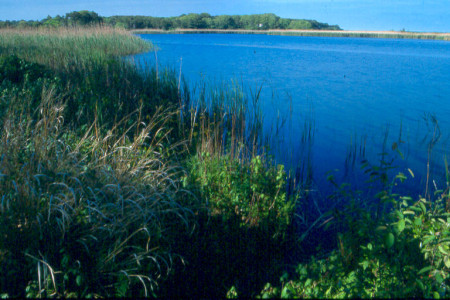Cape Cod Wildlife Conservation Project
CAPE COD WILDLIFE CONSERVATION PROJECT:
A STRATEGY FOR
PRESERVING NATURAL DIVERSITY
2003
EXECUTIVE SUMMARY
The Compact Of Cape Cod Conservation Trusts, Inc.
Introduction
The Cape Cod Wildlife Conservation Project was undertaken to help bring wildlife conservation planning to the forefront in land acquisition and open space management efforts in the region. The results of this analysis are primarily intended to guide the Cape’s private land trusts on land acquisition decisions pertaining to habitat protection. This information, however may also be of general interest and benefit to other conservation-minded organizations involved in wildlife education, protection and habitat management, such as town land bank committees.
The central goal of the project is to preserve and enhance biodiversity on Cape Cod. To achieve this ambitious goal, the project focused upon the identification, mapping and ranking of natural communities, including existing areas held for conservation or other open space purposes. Existing sources were utilized to identify and map twenty-seven distinct community types . By integrating principles of landscape ecology and conservation biology, the project acknowledges the importance of both habitat quantity and quality. Although “bigger is usually better” since larger areas provide greater opportunities to sustain populations, protection of smaller areas, such as sites that contain vernal pools or rare habitat types are also important for maintaining overall diversity. Thus, the project has attempted to determine the habitat requirements for the more than 400 species that are known or expected to occur within Barnstable County (Cape Cod) and map these habitats in order to determine priority areas for protection.
The results of this analysis provide a comprehensive view of the best potential wildlife habitats on Cape Cod based upon natural community type (i.e., vegetation cover, geologic and hydrologic features), size, condition and landscape context . One of the greatest threats to wildlife populations on Cape Cod is the continued fragmentation of habitat resulting from land development practices. This project presents an opportunity to lessen the impact of habitat loss by identifying the most important remaining areas in need of protection for use by those interested in preserving the Cape’s wildlife diversity.
Summary Of Significant Results And Recommendations
Key Results:
· 32 habitat types were identified and mapped. 7,754 individual areas or habitat “patches” were mapped which contained a total of approximately 160,000 acres, or 61 percent of the Cape’s land area.
· Town by town summary tables were prepared which identify the total amount of each habitat type (in acres) mapped and illustrate the distribution of habitat types across the region.
· Most of the highest ranking habitat areas are contained within six large “core” areas which include the Massachusetts Military Reservation, the Sandy Neck/Chase Garden Creek complex in Barnstable/Yarmouth, Punkhorn Parklands in Brewster, Nickerson State Park in Brewster/Orleans, Monomoy National Wildlife Refuge and much of the Cape Cod National Seashore.
· Other significant areas include Bournedale in the northwestern corner of Bourne, Town Neck Beach and marsh system in Sandwich, the town conservation lands in East Sandwich/West Barnstable area, Quivet Neck/Crowe’s Pasture in Dennis and Brewster, Namskaket Creek in Brewster/Orleans, and Herring River/Boat Meadow Creek in Eastham,
· Roughly half (46%) of the identified habitat areas are protected as open space by public agencies or private organizations. Some of these areas may not be adequately protected or managed to maximize conditions for wildlife.
· In general, wildlife habitat is highly fragmented on Cape Cod as a result of land development for residential, commercial, recreation, transportation and other uses. Overall, the average “patch” size mapped, irrespective of habitat type, was approximately 20 acres.
· Forested woodlands are the most common habitat types on the Cape, accounting for 60 percent (104,368 acres) of the total mapped area. The dominant woodland community type is the mixed pitch pine -oak that is characteristic of much of the dry upland sites in the Upper and Mid-Cape region.
· Woodland habitats support the greatest potential number of breeding species (134) than any other habitat type found on Cape Cod. Grasslands and heathlands (52) and wooded swamps (45) support the next highest potential number of species, respectively.
· The most important breeding habitats for the protection of state-listed rare species (Endangered, Threatened, or Special Concern) are coastal plain pondshores, vernal pools, and barrier beaches and dune systems.
· Sandplain grasslands, coastal heathlands, and pitch pine/scrub oak barrens are important rare habitats found on the Cape which also provide habitat for a number of state listed species. Fire suppression, development and natural succession have reduced these open habitats dramatically. Today, these habitat types represent only about two percent of the total area mapped.
· Due to the scarcity of the grassland and heathland communities, there are few opportunities to protect more of these habitat types through outright acquisition. Some expansion and enhancement of these habitats may be achieved through the active management and habitat restoration efforts.
· Approximately 30,000 real estate parcels were identified that contained one or more habitat types. The total area associated with these properties is approximately 138,000 acres. These included existing protected areas, as well as undeveloped and under-developed properties of 2 acres or greater.
· Each parcel was ranked for its conservation value. The criteria used to determine conservation value were parcel size, habitat value, surrounding land uses (context), and percent upland.
· Parcel Ranking Summary: Cape Cod Totals
|
Ranking
|
# of Parcels
|
Acres
|
% Acres Protected
|
| Maximum | 1,633 | 42,763 | 86% |
| High | 11,388 | 61,591 | 48% |
| Medium | 13,382 | 31,174 | 16% |
| Low | 2,810 | 2,923 | 8% |
| Total | 29,213 | 138,451 | 52% |
· More than half (52%) of the total acreage associated with parcels containing some wildlife habitat are protected. According to the ranking, the Cape has managed to protect most (86%) of the highest ranked properties.
· Roughly half of the total area associated with protected parcels occurrs in the following towns: Barnstable, Bourne, Eastham, Sandwich, Truro, and Wellfleet.
· The land area associated with the remaining unprotected parcels is 66,467 acres. The distribution in terms of the habitat ranking is as follows: 5,867 acres in the Maximum category, 31,876 acres in High category, 26,040 acres in Medium category, and 2,683 acres of Low category.
· The towns with the largest amount of unprotected acreage in the Maximum parcel category are: Mashpee (1,412 acres), Harwich (883 acres), Bourne (743 acres), Falmouth (640) and Barnstable (458 acres). This represents 70% of the total acreage in the Maximum category Cape-wide.
· A significant number of opportunities exist to preserve additional habitat areas through land acquisition and other conservation techniques, but few large, unprotected properties remain. The mean size for all parcels evaluated is 4.74 acres. The largest parcel ranked occurs within the Massachusetts Military Reservation in Bourne and is nearly 9,000 acres.
· The greatest opportunity for protecting additional acreage falls within parcels that are ranked in the High and Medium categories. Many of these properties are located adjacent to existing protected open space and may present opportunities to expand existing areas or provide a linkage between habitats using buffers or linear corridors.


